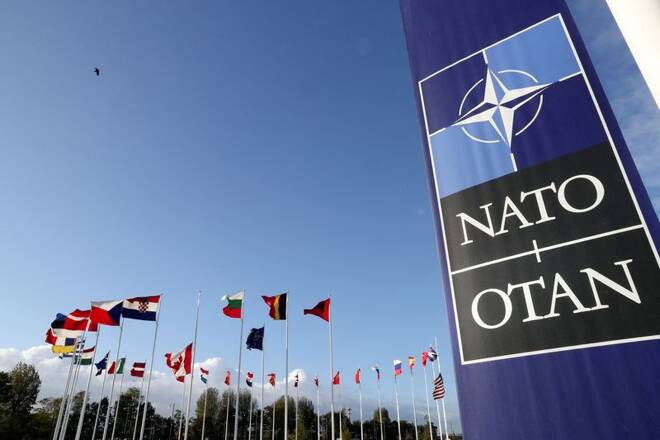Advertisement
Advertisement
Factbox-A brief history of Finland’s and Sweden’s strained ties with Russia
By:
By Anne Kauranen and Johan Ahlander HELSINKI/STOCKHOLM (Reuters) - Finland and Sweden, who are expected to decide this week to apply to join NATO, have long had strained ties with their giant neighbour Russia.
By Anne Kauranen and Johan Ahlander
HELSINKI/STOCKHOLM (Reuters) – Finland and Sweden, who are expected to decide this week to apply to join NATO, have long had strained ties with their giant neighbour Russia.
– Sweden’s and Finland’s difficult past with Russia goes back to 17th and 18th centuries when tsars of the Russian Empire repeatedly tried to conquer Finland, then a hinterland of the Swedish kingdom.
– King Charles XII of Sweden invaded and conquered parts of Russia in the early 18th century but lost a battle in Poltava, in today’s Ukraine, to tsar Peter the Great. It marked the end of Sweden as a major power in Northern Europe.
– Sweden lost Finland to Russia in a war in 1809, turning Finland into an autonomous part of the Russian empire, the Grand Duchy of Finland.
Finland
– In the chaos resulting from the Russian Revolution in 1917, Finland declared its independence on Dec. 6 that year.
– After a few decades of Finnish independence and just before World War II, Nazi Germany and the Soviet Union made a non-aggression pact which included a secret protocol that assigned Finland as well as Estonia and Latvia to the Soviet “sphere of influence”.
– Joseph Stalin’s Red Army attacked Finland in 1939, starting what became known as the Winter War in which Finland fought off the Soviet invasion attempt on its own.
– Finland’s pleas to Western allies for military assistance went unanswered, resulting in Helsinki allying itself with Nazi Germany in a second war against the Soviet Union between 1941 and 1944.
– Finland lost around 10% of its territory to the Soviet Union in the Moscow Armistice in September 1944. It had to relocate 400,000 inhabitants, or 11% of its population, from lost territories and pay war indemnities worth $300 million, equalling some 4.9 billion euros ($5.3 billion) in current exchange rates.
– Finland had to also sign the Agreement of Friendship, Cooperation, and Mutual Assistance with Russia in 1948, cementing a degree of economic and political dependency and isolating it militarily from western Europe.
– Finland’s long-ruling President Urho Kekkonen, in office between 1956 and 1982, focused on maintaining friendly and close relations with Moscow in order to preserve independence by avoiding conflict – a tactic known as Finlandisation.
– Eventually the end of the Cold War allowed Finland to step out of Russia’s shadow and join the European Union in 1995 as well as the eurozone in 1999.
– Joining the EU and signing its mutual defence clause meant Finland switched from formal neutrality to military non-alignment, but Finland opted to stay out of Western defence alliance NATO.
– Up until 2020, only around 20% of Finns wanted Finland to join NATO in polls, with most people believing peace was best kept by maintaining friendly relations and economic ties with Russia.
– Russia’s invasion, which it calls “a special operation”, of its sovereign neighbour Ukraine, resulted in a U-turn among Finns, with around 76% of Finns in favour and only 12% against NATO membership in the most recent poll by public broadcaster YLE.
– “We have seen how Russia behaves in Ukraine. (…) And of course, we need to consider which is the best way to ensure that the same will never happen to Finland,” Finland’s Prime Minister Sanna Marin said ahead of Finland’s NATO decision.
Sweden
– Sweden and Russia have not been at war against each other since 1809, when Sweden lost Finland to Russia.
– Sweden lent some military aircraft to Finland when it was attacked by Russia during the Winter War in 1939, but it remained neutral throughout the World War Two and the Cold War.
– Sweden’s official role as neutral allowed it to be a vocal critic of both the Soviet Union and the United States but had a secret deal that the U.S. would come to Sweden’s defence in case of a Soviet attack from the 1960s and forward.
– Sweden and the Soviet Union had several diplomatic skirmishes throughout the Cold War, often involving alleged or proven submarine infringements of Swedish waters by the Soviets.
– The most serious incident of the 50s came when Soviet war planes downed two Swedish aircraft, one military and one civilian, within a few days of each other over the Baltic Sea in 1952. The Soviet Union did not officially acknowledge it shot down the planes until 1991.
– In 1981, in what in the West was dubbed the Whiskey on the Rocks incident, a Soviet Whiskey-class submarine ran aground on the coast in southern Sweden. Sweden said it detected radiation that indicated that the vessel was armed with nuclear weapons. After 10 days of tense diplomatic exchanges the submarine was tugged off the rocks and returned to the Soviets.
($1 = 0.9283 euros)
(Reporting by Anne Kauranen in Helsinki and Johan Ahlander in Stockholm; Editing by Raissa Kasolowsky and Angus MacSwan)
About the Author
Reuterscontributor
Reuters, the news and media division of Thomson Reuters, is the world’s largest international multimedia news provider reaching more than one billion people every day. Reuters provides trusted business, financial, national, and international news to professionals via Thomson Reuters desktops, the world's media organizations, and directly to consumers at Reuters.com and via Reuters TV. Learn more about Thomson Reuters products:
Advertisement
